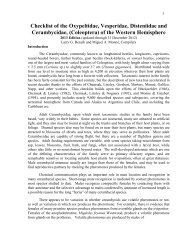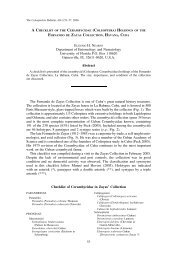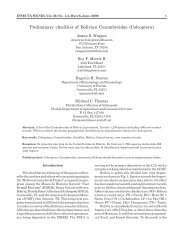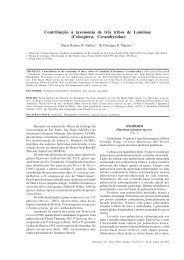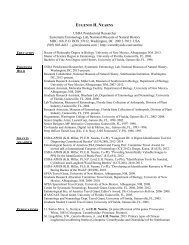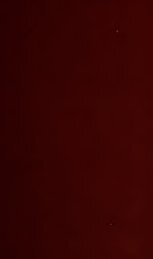Create successful ePaper yourself
Turn your PDF publications into a flip-book with our unique Google optimized e-Paper software.
LAWRENCE S. DILLON <strong>AND</strong> ELIZABETH S. DILLON 125<br />
dull fulvous variegated pubescence; tarsi sparsely hoary pubescent. Antennae fulvous,<br />
distal segments much paler, entirely hoary pubescent, apices of fourth to<br />
seventh segments somewhat mottled with brownish, scape and third segment variegated<br />
with dull fulvous.<br />
Head minutely punctate, with a median line from occiput to epistoma; front<br />
broad, subquadrate, broadly and feebly concave between antennal tubercles, minutely,<br />
densely punctate, without larger punctures or impressions; genao vertical,<br />
minutely, densely punctate and with large, feebly impressed, scattered punctures;<br />
eye with lower lobe elongate-oblong, narrowed below, one and one-fourth times the<br />
height of gena; antennal tubercles widely separated, robust, feebly prominent,<br />
inner side of apex with along, narrow tooth (or very short horn), curved laterally.<br />
Pronotum strongly transverse, two-thirds again as wide as long; sides broadly arcuate,<br />
gradually narrower apically, behind middle a feebly elevated, small tubercle,<br />
without a process; apical transverse sulcus sinuous, feebly impressed, basal one<br />
broad, moro distinct, coalescent with the indistinct, lateral oblique ones; disk with<br />
an elongate, feeble elevation at middle, each side broadly, not very strongly tumid,<br />
base and sides coarsely, sparsely punctate. Scutellum small, strongly transverse, sides<br />
straight, slightly oblique, apex truncate. Elytra with sides straight, very slightly<br />
tapering to apices, which are separately, angularly rounded; disk with coarse punctures<br />
arranged compactly, more or less in irregular rows, on apical third punctures<br />
abruptly finer, with soveral very indistinct costae on apical two-thirds; humeri<br />
scarcely prominent, anterior margin rounded, strongly oblique, angle with a small,<br />
prominent tubercle. Prosternum simple, convex, gradually wider posteriorly; mesosternum<br />
anteriorly with a large, right angular tubercle. Legs rather short, robust;<br />
procoxae slightly tumid posteriorly, unarmed before; femora very robust, strongly<br />
clavate, profemora coarsely rugose at extreme base of posterior face; tibiae equally<br />
robust; protarsi dilated. Fifth sternite slightly longer than fourth, apex broadly<br />
retusc. Antennae rather slender, slightly longer than body, sparsely fimbriate be<br />
neath nearly to apex; scape moderately robust, arcuate, gradually clavate almost<br />
from base, not at all rugose; third segment one and one-half times length of first,<br />
robust, nearly straight; fourth as long as scape, rest gradually shorter.<br />
LENG'£H 9 mm.; width 3.4 mm.<br />
Type locality.Cordova, Mexico, and Belize, British Honduras.<br />
Distribution.Southern Mexico and British Honduras.<br />
MEXICO: a, Santa Rosa, V. C., August; (Wm. Schaus); [U.S.N.M.].<br />
GLYPTHAGA Thomson<br />
Glypthaga Thomson, Physis, II, 1868, p. 64. Lacordaire, Gen. Col., IX, 1872, p.<br />
667, 673. Bates, BioI. Centr.-Amer., Col., v, supp!., 1885, p. 366.<br />
Closely related to Hesycha but differs from that genus in being<br />
more attenuate j antennae having the third and fourth segments<br />
much heavier than others (especially in male) j mesosterna! process<br />
apically retuse j disk of pronotum much less swollen j eye with<br />
lower lobe much larger and oblong.


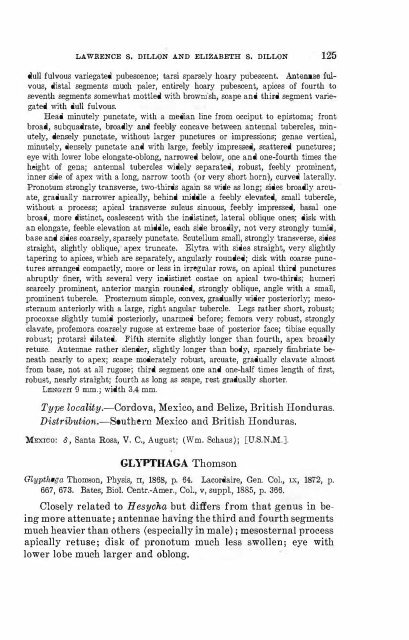
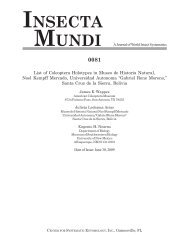
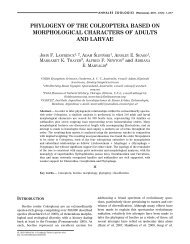


![Coleoptera. Vol. I. [Longicornia. Part I.]](https://img.yumpu.com/41202793/1/180x260/coleoptera-vol-i-longicornia-part-i.jpg?quality=85)

